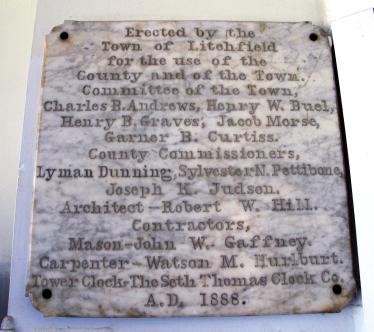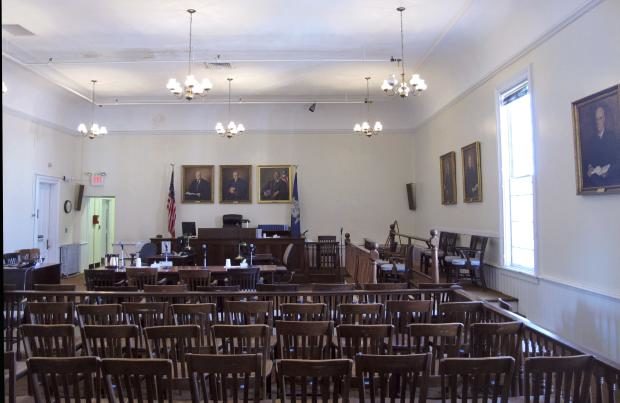Odd inheritance: 1889 landmark courthouse with clock tower

This Wednesday, Aug. 23, 2017 photo shows a plaque at the Litchfield Judicial District Courthouse in Litchfield, Conn.
LITCHFIELD, Connecticutt — George Beckwith got the surprising phone call a few months ago, informing him that he soon would be an owner of a 19th-century courthouse in Connecticut, nearly 2,253 kilometers (1,400 miles) from his home in Missouri.
The 78-year-old resident of Goodman, in southwestern Missouri, knew about the unusual lease agreement his ancestors had signed with Connecticut officials in 1803. If Connecticut ever stopped using the property in Litchfield for a courthouse, the parcel would revert back to descendants of the six landowners who leased it to the state.
Beckwith never thought Connecticut would abandon the landmark 1889 courthouse, which features a Seth Thomas clock tower and lies along the historic Litchfield Green. But that’s exactly what was happening, his lawyer, Michael Rybak, told him in that phone call.
“Just out of the blue, the state of Connecticut got a hold of Mike Rybak and they said they were going to hand over the keys,” said Beckwith, who grew up in Litchfield. “It was certainly startling.”
The state closed the Litchfield Judicial District Courthouse on Aug. 25 and transferred operations to a new $80 million courthouse a few miles away in Torrington. Officials had planned to continue some judicial functions in the granite building after the move to Torrington but abandoned the idea because of the state budget deficit, judicial branch officials said.
Article continues after this advertisementBeckwith said he had no use for a courthouse or the expenses that came with it, so he went looking for options before the state planned to hand it over on Sept. 30.
Article continues after this advertisement
A plaque at the Litchfield Judicial District Courthouse. (Photo by DAVE COLLINS /AP)
The search didn’t take long. The nonprofit Greater Litchfield Preservation Trust has agreed to purchase Beckwith’s interest in the property for an undisclosed, below-market-value price, Rybak said. The trust is the parent organization of two partnerships that own and operate two other buildings in Litchfield.
The trust intends to keep the building open and “repurpose” its use, said its attorney, Perley Grimes. There are no specific proposals yet, he said.
Ownership of the property actually will pass to Beckwith and his two late sisters’ estates, which also are expected to sell their interests to the trust, said Rybak, who also represents the estates. Descendants of the other land owners lost out on ownership rights because their interests were not legally passed down through the generations, Rybak said.
The property was leased to the state by landowners Moses Seymour, Moses Seymour Jr., Roger Skinner, Aaron Smith, Elijah Wadsworth and Frederick Wolcott. The Beckwiths are descendants of the Seymours.
“In 40 years of practice, I’ve never seen anything like this,” said Rybak, who has advocated since the late 1970s to keep the Litchfield courthouse open amid various plans to close it. “But then again, there are not too many properties like this.”
People who worked at the courthouse have mixed emotions about its closure. A piece of history is being lost. But the building had grown cramped, there were accessibility problems for the disabled and there were security concerns, including judicial marshals having to transport prisoners through public areas of the courthouse.
“It’s quite a piece of history,” said Judge John Pickard, who worked at the courthouse the past 15 years. “I think we have all loved being here. But it doesn’t have modern facilities. It’s time.”
The courthouse is the most prominent landmark in the Litchfield Historic District, which is listed on the National Register of Historic Places. Two previous courthouses on the same property burned down.
It was host for decades to Litchfield County’s civil court cases, as well as the region’s most serious criminal cases, including the well-publicized murder trial of teenager Peter Reilly.
Reilly was convicted of killing his mother in Falls Village in 1973 but exonerated four years later after playwright Arthur Miller and others helped Reilly find a top defense attorney.

The second-floor courtroom of the Litchfield Judicial District Courthouse. (Photo by DAVE COLLINS /AP)